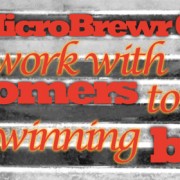MicroBrewr 079: The importance of budgeting for working capital
Podcast: Play in new window | Download | Embed
Subscribe: RSS
Wim Bens was born in Belgium and moved to Texas when he was 7 years old. He applied to American Brewers Guild just to have the option. Now, 3 years after opening Lakewood Brewing Co. in Garland, Texas he can barely keep up with demand.
“If you start doubting what you’re doing, then you shouldn’t be doing it.” [Tweet This]
Wim’s original business plan called for 3 employees, adding about 1 employee per year, for every 1,000 barrels produced. They had planned to expand production to 7,000 barrels in year 7.
Two years later after opening, they had 13 employees and had started looking for a larger venue.
Today, just 3 years after opening, Lakewood Brewing Co. has a staff of 22. They produced 7,500 barrels last year, are on track to produce 10,000 barrels this year. They are projecting next year’s production at 15,000 – 20,000.
RELATED: MicroBrewr 077: The importance of writing your goals.
Wim says you must have:
- Good culture
- Good people
- Investment
- Ability to invest at the right time
- Make smart investments in your business
- Good beer
- Consistently good beer
“And I think if all those things come together, especially in a market like Dallas-Fort Worth that had a local beer drought, then you have a good recipe for success,” advises Wim.
On convincing family, friends, and fools to invest in your brewery:
- It’s very important to believe in yourself.
- It’s very important to believe in what you’re doing.
- Hire people who are smarter than you.
“If you start doubting what you’re doing,” says Wim, “then you shouldn’t be doing it.”
“A lot of people think when they open a small brewery, “I’m going to be the brewer.’ Ok, well who’s going to do payroll? And who’s going to do HR? And who’s going to be ordering supplies? And who’s going to be doing facility maintenance? And who’s going to be doing all your advertising? And who’s going to be doing distribution?
“There are so many things that have to happen in a brewery to be successful that you have to be able to delegate that and hire people who are experts in those fields.”
Wim reminds us to budget for working capital. His advice is to double your budget—and then add 20%.
“Working capital is not talked about enough,” says Wim. “You have to have enough money to pay your employees, to order your raw materials in large amounts so that you get a quantity discount so that you can eventually turn that into a more profitable margin. You have to have a lot of working capital until you start seeing the money come back.”
Brewery specs:
Kettle size: 30 BBL.
Size and quantity of fermentation tanks: 30-180, 1,440 BBL total fermentation vessel capacity.
Size and quantity of bright tanks: 180, 90, 80, 60, 40.
Annual brewing capacity/last year’s production: 2014: 7,500 BBL.
Square footage: 30,000 sq. ft.
Years in operation: 3 (opened August 2012).
Listener question:
From Peter Stillmank: How much beer do you need to produce each year to break even?
Can’t-go-without tool:
Book recommendation:
- Yeast: The Practical Guide to Beer Fermentation (Brewing Elements) by Chris White and Jamil Zainasheff.
Check out the entire list of recommended books, click here.
An upcoming beer style:
Sour beers
Other resources:
- American Brewers Guild, education for working or would-be brewers who can’t get away.
- Brewers Association, promoting independent craft brewers.
- Stop calling beers ‘sours,’ Joe Stange, DRAFT Magazine, June 25, 2015.
You can reach Wim Bens and Lakewood Brewing Co. at:
- lakewoodbrewing.com
- Facebook: LakewoodBrewing
- Twitter: LakewoodBrewing
- Instagram: lakewoodbrewing
- Untappd: lakewoodbrewing
Sponsors:
Support MicroBrewr
Help keep MicroBrewr on the air. CLICK HERE for ways you can help.















There was lot of good advice. A few things I liked the most were how higher ceiling space could reduce square footage for the brewery and also in hot climate overheads could be very high just because of air conditioning so if there is a flexibility in choosing a location choose a place where most beers if possible could be brewed using as much ambient temperature as possible.
The one question that has been missing that should be asked is “Naming a Beer”. Usually consumers do not realize flavor nuances and they would associate flavors potentially with the name. IPA s and some other beers people know exactly what to expect but for nuances of flavors- name I guess influences choice.
Wow, how to name a product could probably be taught over a whole semester. I imagine a TON of psychology, market research, opinion panels, and just luck go into naming the best selling products. Maybe we can find someone from a big marketing firm to talk with us for a whole podcast about this subject… Thanks for sharing your thoughts, Akhil.